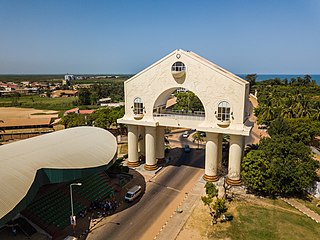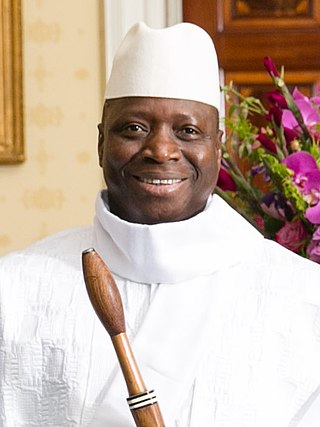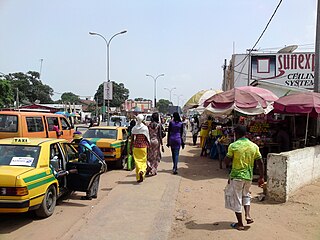
The Gambia, officially the Republic of The Gambia, is a country in West Africa. Geographically, The Gambia is the smallest country in continental Africa; it is surrounded by Senegal on all sides except for the western part, which is bordered by the Atlantic Ocean.

Banjul, officially the City of Banjul, is the capital of The Gambia. It is the centre of the eponymous administrative division which is home to an estimated 400,000 residents, making it The Gambia's largest and most densely populated metropolitan area. The city Banjul is located on St Mary's Island, where the Gambia River enters the Atlantic Ocean.

Yahya Abdul-Aziz Jemus Junkung Jammeh is a Gambian politician and military dictator who overthrew the elected government and became President of the Gambia from 1996 to 2017, as well as Chairman of the Armed Forces Provisional Ruling Council (AFPRC) from 1994 to 1996.

Bakau is a town on the Atlantic coast of Gambia, west of Gambia's capital city of Banjul. It is known for its botanical gardens, its crocodile pool Bakau Kachikally and for the beaches at Cape Point. Bakau is the first major suburb outside Banjul and the most developed town in the Gambia. Close to Bakau and Banjul is Gambia's largest city, Serekunda.

Kanifing is a municipality, local government area and district in the Gambia. It is part of the Greater Banjul Area, to the west of Banjul, and is governed by Kanifing Municipal Council (KMC).

The People's Progressive Party is a political party in the Gambia. It was the dominant ruling party of the House of Representatives and the presidency from 1962 to 1994. The president throughout this time period was Dawda Jawara. The People's Progressive Party lost power after the 1994 Gambian coup d'état, a military coup led by young, junior military officers. The Alliance for Patriotic Reorientation and Construction (APRC) then became the dominant party of the Gambia. The People's Progressive Party remains active, but lacking the same level of support it garnered in the 20th century.
Sheriff Mustapha Dibba was a Gambian politician who was the 1st Vice-President of the Gambia (1970–1972) and also served as the country's National Assembly speaker from 2002 to 2006. He was also leader of the National Convention Party (NCP).

Halifa Sallah is a retired Gambian politician and former National Assembly member for Serrekunda Constituency. He currently serves as the secretary-general of the People's Democratic Organisation for Independence and Socialism (PDOIS). He served as a spokesman and advisor to President Adama Barrow from during the 2016 presidential election campaign until March 2017.

Mama Kandeh is a member of the Pan-African Parliament from the Gambia. He is the founding leader of the Gambia Democratic Congress (GDC) political party, which he formed in the summer of 2016. He ran as a candidate in the Gambian presidential election of 2016 and received 17.1% of the votes.

Alieu Ebrima Cham Joof commonly known as Cham Joof or Alhaji Cham Joof, was a Gambian historian, politician, author, trade unionist, broadcaster, radio programme director, scout master, Pan-Africanist, lecturer, columnist, activist and an African nationalist who advocated for the Gambia's independence during the colonial era.
Amadou Scattred Janneh is a Gambian politician with Gambian and American dual citizenship. A former Minister of Information and Communication for the national government, he was sentenced to life in prison for treason after distributing T-shirts with the slogan "End to Dictatorship Now". After international protest from organizations including Amnesty International and an appeal by US activist Jesse Jackson, Janneh was pardoned and returned to the US.
Gambia Coalition 2016 was the governing coalition of The Gambia in the late 2010s, consisting of seven Gambian political parties, civil society groups and one independent candidate created to field and support a unity ticket for the opposition in the 2016 presidential election. The coalition selected real estate developer and deputy treasurer of the United Democratic Party (UDP) Adama Barrow as their candidate. Barrow officially left the UDP to allow him to run as an independent candidate, although his candidacy continued to be supported by the UDP through its membership in the coalition.
Fatou Mass Jobe-Njie is a Gambian politician who served as Minister of Tourism and Culture from 2010 to 2014 and ambassador to Malaysia from 2014 to 2015.
Momodou Lamin K. Sanneh is a Gambian politician who served as Deputy Speaker of the National Assembly from 2017 to 2022. He is a member of the United Democratic Party (UDP) and served as the National Assembly Member (NAM) for Kiang West from 2007 to 2012, as well as the National Assembly Minority Leader in the same time period.
Sayerr Jobe was the founder of Serekunda, the largest city in The Gambia.

TheGambia–India relations refers to the international relations that exist between The Gambia and India. The Gambia maintains a High Commission in New Delhi. The Embassy of India in Dakar, Senegal is concurrently accredited to The Gambia, the only Anglophone country accredited to that mission. India also maintains an Honorary Consulate General in Banjul.

Latri Kunda is part of the Kanifing District, and a suburb of Sere Kunda in The Gambia.
Fatou A. "Toufah" Jallow is a Gambian beauty queen. She became known in 2014 for her accusations of rape and sexual harassment against Gambian President Yahya Jammeh.
Capital punishment remains a legal penalty for multiple crimes in The Gambia. However, the country has taken recent steps towards abolishing the death penalty.























